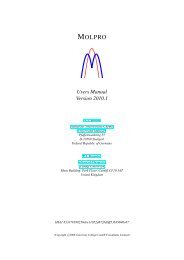Hydrophobic, Highly Conductive Ambient-Temperature Molten Salts†
Hydrophobic, Highly Conductive Ambient-Temperature Molten Salts†
Hydrophobic, Highly Conductive Ambient-Temperature Molten Salts†
Create successful ePaper yourself
Turn your PDF publications into a flip-book with our unique Google optimized e-Paper software.
<strong>Ambient</strong>-<strong>Temperature</strong> <strong>Molten</strong> Salts Inorganic Chemistry, Vol. 35, No. 5, 1996 1171Table 2. Melting Points (°C) of the Imidazolium SaltsIm + TfO - NfO - Tf 2N - TA - HB -3-Me1-Me 39 22 521-Et -9 28 -3 -14 a1-Bu 16 20 -4 a a1-i-Bua1-MeOEt 27 a1-CF 3CH 2 45 a3-Et1-Et 23 14 a1-Bu 2 21 a a1-Et2,3-Me 2 109 20 592-Et-3-Me 113 281-Et-5-Me3-Me 6 -33-Et 35 -22aCould not be crystallized. Turned into a glass between -30 and-50 °C.rationalized based on the top-to-bottom structure proposed byWelton (structure I). It can be assumed that the stacking willtake place the closest to that model for the most tightly boundion-pairs, which means for the most basic anions. With aconcentration increase, the H(2) entering the shielding cone ofthe neighboring imidazolium moves to lower shifts while theH(4) and H(5), pointing outside, remain only influenced byH-bonding strenghtening. At the other extreme, Tf 2 N - , the leastbasic anion, appears unable to H-bond, as indicated by thehydrophobicity of its imidazolium salts. Ion-pairing probablyproceeds at random, without preferential orientation, andagreggation can occur with H(2) as well as H(4) or H(5) in theshielding cone of the neighboring imidazolium ring. Referringto the X-ray structure of EtMeIm + PF - 6 , 7b one can in fact assumethat there is no proper stacking in dialkylimidazolium salts ofnon-hydrogen-bonding anions, but only randomized agreggation.Melting Points (Table 2). The melting points are difficultto correlate with the chemical composition of the salts. 1,3-Dialkylimidazolium bis(triflyl)amides, trifluoroacetates, andheptafluorobutanoates are generally liquid up to -30 to -50°C and become increasingly viscous, turning finally into glasses.EtMeIm + AcO - behaves identically. Triflates and nonaflatesoften melt close to room temperature, except 1-Et-3-MeIm + -TfO - , for which the melting point corresponds to that reportedpreviouly. 2 The effect of cation symmetry is obvious: Me 2 -Im + and Et 2 Im + salts present higher melting points than thesalts with unsymmetrical cations.It appears from the examination of the anion series that thereare no obvious correlations between H-bonding ability andmelting point. A strongly H-bonding anion with weak chargedelocalization (AcO - ) forms an EtMeIm + salt of very low glasstransition temperature but an anion unable to H-bond andbearing a strongly delocalized charge (Tf 2 N - ) also does. It wasexpected at first that suppressing the C(2)-H‚‚‚X - H-bond byalkyl substitution would lower the melting point. The oppositeIFigure 3. Thermogravimmetry in air of EtMeIm + Tf 2N - andEtMeIm + TA - .was observed; C(2) methylation or ethylation increases themelting point by 50 to 120 °C and makes the vitrous solidsquite crystalline. Methylation in the 5-position also augmentsthe melting point, albeit to a lesser extent.The influence of H-bonding and charge delocalization canonly be understood for structurally similar anions such as TfO -and Tf 2 N - . The lower melting point of the latter is probablyrelated to its inability to H-bond and to its better chargedelocalization. This hypothesis is supported by the largedifference between the melting point of EtMeIm + TfO - andCF 3 CH 2 MeIm + TfO - , the trifluoroethylated imidazolium beingmore susceptible to H-bonding due to the CF 3 CH 2 electronwithdrawingeffect on the Im + ring (see NMR). No suchdifference is noticed for the Tf 2 N - analogues. The effect ofthe cation symmetry on the other hand, appears for both Tf 2 N -and TfO - salts.The van der Waals interactions have only a slight influenceon the melting point, obvious only when comparing triflatesand nonaflates of the same cations. Alkyl chain lengtheningon the cation can lead to opposite effects.Thermal Stability. The thermal stabilities of EtMeIm +TfO - ,Tf 2 N - , and TA - in air as well as under nitrogen weredetermined on a Mettler thermogravimmetric balance at aheating rate of 10 °C/min. The two former were stable up to400 °C and decomposed rapidely between 440 and 480 °C ataconstant rate, both in air and under N 2 . The latter was muchless stable and started to decompose at 150 °C in air or N 2 , theprocess lasting up to 250 °C, in a more complex mode asillustrated in Figure 3.Miscibility with Other Liquids. All the investigated moltensalts are miscible with liquids of medium and high dielectricconstant (ɛ): low alcohols and ketones, dichloromethane (ɛ )8.93), and THF (ɛ ) 7.58). They are immiscible with alkanes,dioxane (ɛ ) 2.01), toluene (ɛ ) 2.38), and diethyl ether (ɛ )4.33). Ethyl acetate (ɛ ) 6.02) appears to constitute theborderline. EtMeIm + TfO - , NfO - , and Tf 2 N - are miscible withthis solvent, while TA - and HB - are slightly soluble. Alkylchain lengthening increases the solubility: BuMeIm + TA - andBuMeIm + HB - are miscible with ethyl acetate.Triflates, trifluoroacetates, and heptafluorobutyrates are misciblewith water (Table 3) for all the dialkylimidazolium cationsinvestigated (up to BuEtIm + ). Nonaflate miscibility is limitedearly by alkyl chain lengthening. All the bis(triflyl)amides areimmiscible with water, reflecting the absence of H-bondingability of the anion. Alkyl chain length has no strong influencein this case. The saturating water content is the same forEtMeIm + Tf 2 N - and for BuMeIm + Tf 2 N - . It is slightly higherfor the MeOC 2 H 4 MeIm + and CF 3 CH 2 MeIm + salts due toincreased H-bonding possibilities with the cation, caused by thepresence of an oxygen atom in the side chain for the former











![Hetero [6+3] Cycloaddition of Fulvenes with N-Alkylidene Glycine ...](https://img.yumpu.com/35423358/1/190x245/hetero-6-3-cycloaddition-of-fulvenes-with-n-alkylidene-glycine-.jpg?quality=85)




